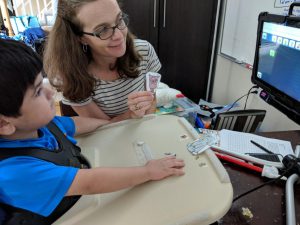 “Seagull being fixed” Joey said to me as I was putting away the materials from one activity and transitioning us to the next. “Really?” I asked, “a seagull? What happened?”
“Seagull being fixed” Joey said to me as I was putting away the materials from one activity and transitioning us to the next. “Really?” I asked, “a seagull? What happened?”
“Sunny. Hurt.”
“The seagull was hurt? And needed to be fixed? Or was it a seagull? Was something else being fixed?”
“Reading. Broken.”
“Reading? Did the book break? Something is broken. Did a bird in the book break?
“Goldfish. Sick. All gone.”
I can’t even remember all of my responses to Joey’s words, but nothing I said was able to clarify the details of the story Joey was trying to tell me. He’d just come back from a beach vacation. Had he seen a hurt seagull? Did he mean to select seagull, or had he intended to choose another word? The street outside his house is being worked on and we could hear the work trucks. Was he telling me about the road being fixed? He’d eaten a goldfish cracker the day before – was he telling me he’d broken it with his teeth since eating crunchy foods is a relatively new skill for him? Was he telling me a series of stories – a seagull he saw at the beach, and that he’d eaten goldfish and now they were all gone? This too could be possible. Four-year-olds do have a tendency to group stories, especially if they feel they only have a limited window to tell you the highlights of their life.
Joey used every word he had on his device that related to being hurt – hurt, broken, sick, fixed. His grandmother and I stood next to him trying to clarify, but we couldn’t.
In replaying the situation my heart hurts. Without context it can be hard to determine what he is trying to tell us. Sometimes he selects words accidentally and it can take 3 or 4 tries for him to get the word he intends to select. So if we assign meaning to the unintended words, we change his message. But if we disregard what he is trying to tell us we not only miss out on the story he is trying to tell us, but also the opportunity to show Joey the power of communication, serve-and-return, and how we can tell stories and share ideas with one another.
Looking back, I wish I could rewind those moments and slow myself down. I rushed forward, not wanting him to get too uncomfortable with us not understanding him. I also had this small idea that if we went ahead with our book we would figure out what he was talking about. Yet we didn’t, and the moment passed. We went on with our activities and Joey was pleasant and talkative, both with his AAC device and vocally. But I can’t stop wanting to rewind the moment.
This is a wonderful reminder to myself to pause and slow down my work with Joey. So often what he needs is a communication partner – not a teacher. I might have an agenda I want to cover, but I can never forget that the overall goal is Joey’s communication. Stopping and allowing him to tell his stories is more powerful than completing my objectives. And giving him the opportunity to see that I care about what he’s telling me – to ask questions, follow up, is important too. I need to help him learn how to be persistent with his communication.
In the moment I was uncomfortable that I couldn’t understand his message, both for myself and for him. I wanted to ease any communication frustration he may have had and make the moment OK. As teachers and therapists how often do we react like this when we are working with children learning to communicate? Especially with children with apraxia, stuttering, or who have difficulty with word recall? We want to ease everyone around us – make the situation easier on the speaker and on the listeners.
I also see this when we are connecting with the elderly who have difficulty finding their words, especially if we know that in the prime of their life they would never have paused to word-search. We jump in and ease the moment.
But in our moments of smoothing over the rough edges of the moment we lose the opportunity for the speaker to learn how to find the words, clarify the message, and confirm understanding. Perhaps what’s more important than anything is allowing Joey to gain confidence that he can clarify his message, and that a few minutes of making his listener uncomfortable is OK in order to get his message across. His words are important to listen to, and worthy of everyone else’s time.


